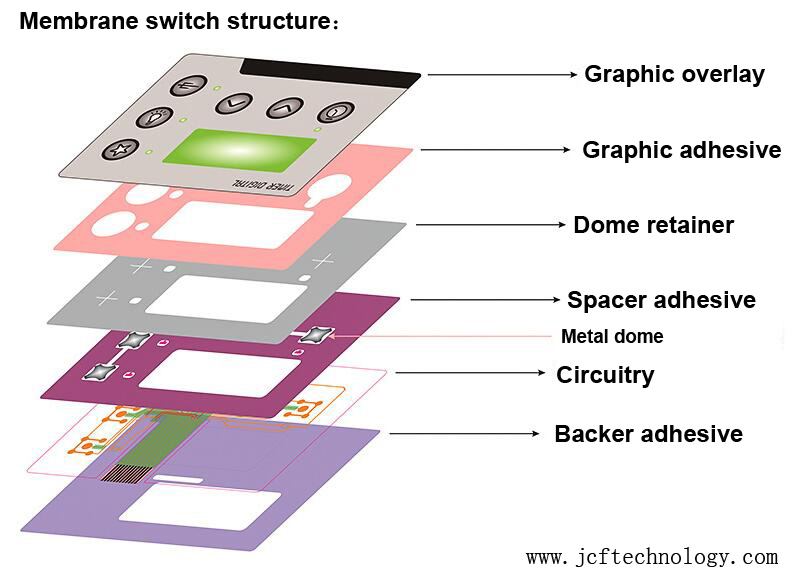Comprehending Membrane Changes: The Key to Dependable and resilient Controls

What Are Membrane Switches?
Membrane buttons are a sophisticated solution in the world of interface technology, integrating functionality and style perfectly. These tools serve as an interface in between users and digital systems, integrating numerous elements right into a compact layout. Normally created from adaptable, slim layers of materials, membrane buttons are made to react to touch, making it possible for individuals to communicate with machinery and digital devices properly.
The main aspects of a membrane layer switch include a published circuit layer, graphic overlay, and a spacer layer that stops unintentional activation. The graphic overlay can be personalized to mirror brand name identification or user preferences, enhancing aesthetics while making certain use. Membrane switches are frequently utilized in various applications, consisting of clinical gadgets, customer electronic devices, and commercial tools, owing to their longevity and resistance to ecological aspects such as wetness and dust.
Among the vital advantages of membrane buttons is their capability to withstand deterioration, making them ideal for high-traffic atmospheres. In addition, they are lightweight and call for very little space, enabling cutting-edge styles in product development. In general, membrane layer switches stand for a useful and effective option for contemporary digital interfaces, marrying technology with user-centric design principles.
Just How Membrane Layer Changes Job
The procedure of membrane changes depend upon a basic yet efficient mechanism that equates individual input into digital signals. These buttons contain several layers, commonly including a visuals overlay, a spacer layer, and a circuit layer. When an individual presses the button, the top layer deforms, allowing a conductive element in the circuit layer to reach an equivalent conductive pad on the bottom of the visuals overlay. This get in touch with shuts the circuit and sends an electronic signal to the device, showing that the switch has been activated.
The layout of membrane layer buttons can vary, however they often include domes or responsive elements to give comments to the user, boosting the total experience - membrane switch. The products utilized in membrane layer switches, such as polyester or polycarbonate, add to their sturdiness and resistance to environmental elements, including wetness and dust. Additionally, the printed circuits are commonly encapsulated, which safeguards them from deterioration over time.
Advantages of Membrane Layer Switches

Furthermore, membrane layer switches are recognized for their toughness. Created from robust products, they are resistant to dust, moisture, and physical wear, which dramatically expands their life expectancy contrasted to traditional mechanical switches. This toughness makes them especially suitable for high-traffic settings and applications calling for long life.
An additional substantial advantage is the simplicity of cleansing and upkeep. The smooth surface area of membrane switches decreases dirt build-up and is frequently unsusceptible spills, making them suitable for settings that need frequent sanitization.
Additionally, membrane switches supply a streamlined account, causing a thinner style that can be integrated into different devices without adding mass. This function not only improves the visual charm however also adds to a more ergonomic item layout.
Applications of Membrane Layer Buttons
Functional and easy to use, membrane buttons find applications throughout a large range of sectors, including medical gadgets, customer electronics, and commercial devices. In the clinical area, these buttons are indispensable to tools description such as Click This Link analysis devices, person surveillance systems, and infusion pumps, where reliability and ease of cleansing are critical. Their capability to maintain and stand up to extreme environments functionality makes them optimal for such applications.

In customer electronic devices, membrane layer switches are used in products like microwaves, washing makers, and remote controls - membrane switch. Their sleek design permits user-friendly user interfaces, enhancing the overall user experience while providing resilience and resistance to deterioration
Industrial tools additionally takes advantage of membrane layer switches, particularly in control panels for equipment and automation systems. These buttons provide defense against dirt and moisture, guaranteeing constant efficiency in challenging atmospheres. Their personalized functions allow makers to tailor them to particular operational demands, improving effectiveness and capability.
Selecting the Right Membrane Layer Switch Over
When selecting a membrane switch, it is necessary to consider various variables that affect performance and suitability for certain applications. The primary factors to consider include environmental conditions, tactile responses, sturdiness, and layout specs.
First, assess the operating environment; switches exposed to dampness, chemicals, or extreme temperatures need certain materials to ensure durability and performance. Next off, evaluate the requirement for tactile responses. Depending upon individual communication, some applications may benefit from a tactile response to confirm activation, while others may like a non-tactile design for aesthetic reasons.
Longevity is an additional important aspect; membrane layer switches need to be developed to stand up to constant usage, influences, and find here abrasion. Guarantee the picked switch can withstand the expected lifecycle, particularly in high-usage scenarios.

Final Thought
In verdict, membrane switches serve as vital components in the design of reliable and durable control systems throughout various industries. The flexibility of membrane changes permits for customized remedies that satisfy details functional needs, reinforcing their importance in modern-day technology.
Membrane layer switches represent an important element of contemporary interface layout, blending capability with durability in various applications.Membrane switches are an advanced option in the world of customer interface technology, combining performance and layout perfectly. Typically built from versatile, thin layers of products, membrane buttons are designed to react to touch, making it possible for individuals to connect with machinery and digital gadgets successfully.
The design of membrane switches can differ, however they often incorporate domes or tactile elements to offer feedback to the user, boosting the overall experience.In verdict, membrane layer switches serve as crucial parts in the design of sturdy and trusted control systems across various industries.